Current Status of Circular Economy Research in Finland
Abstract
:1. Introduction
- Current state and trends of resource-efficient circular economy
- Overall barriers and drivers for the future development of circular economy
- Identification of potential key sectors, activities, and materials
2. Policy Timeline in Europe and Finland
2.1. Circular Economy Package 2015
2.2. Finnish Roadmap to Circular Economy 2016
2.3. Finnish National Waste Plan 2018
- i.
- Construction and demolition waste
- ii.
- Biodegradable waste
- iii.
- Municipal solid waste
- iv.
- Waste electrical and electronic equipment (WEEE)
2.4. Circular Economy Package 2018
- EU strategy for plastics in circular economy with the aim of transforming plastic product design, production process, use, and recycling [11].
- Communication to assess the relationship between chemical, product and waste legislation, how some chemicals can hinder reuse and recycling and, therefore, the transition toward circular economy [12].
- Monitoring framework with a set of ten key indicators to assess the progress of transition toward circular economy in each phase of resources, products and services life cycle in this package. These ten key indicators are selected in a way that they capture the main elements of a circular economy and provide a wide perspective of key leverage points to increase the circularity in the European economy [13].
- Report on critical raw material in the circular economy and the potentials of more circular usage of the 27 critical raw materials in the economy [14].
2.5. The European Green Deal 2019
2.6. The Circular Economy Action Plan 2020
- Electronics and ICT
- Batteries and vehicles
- Packaging
- Plastics
- Textiles
- Construction and buildings
- Food, water, and nutrients
3. Methodology
4. Results and Discussion
5. Conclusions
Author Contributions
Funding
Acknowledgments
Conflicts of Interest
Research Highlights
- The influence of circular economy policies and national strategies on research trends is noticeable.
- Recycling-based interpretation of circular economy seems to dominate over the waste prevention-based approaches.
- Design for environment and sharing economy should be prioritized more in research.
References
- Giusti, L. A review of waste management practices and their impact on human health. Waste Manag. 2009, 29, 2227–2239. [Google Scholar] [CrossRef] [PubMed]
- European Commission. Circular Economy Stakeholder Platform, Circular Economy Stakeholder Conference: Success Stories and New Challenges. Brussels Belgium. 2019. Available online: https://circulareconomy.europa.eu/platform/en/node/1301 (accessed on 26 October 2020).
- European Commission. Communication from The Commission to The European parliament, The Council, The European Economic and Social Committee and the Committee of the Regions, The European Green Deal; European Commission: Brussels, Belgium, 2019. [Google Scholar]
- Ghisellini, P.; Cialani, C.; Ulgiati, S. A review on circular economy: The expected transition to a balanced interplay of environmental and economic systems. J. Clean. Prod. 2016, 114, 11–32. [Google Scholar] [CrossRef]
- Lieder, M.; Rashid, A. Towards circular economy implementation: A comprehensive review in context of manufacturing industry. J. Clean. Prod. 2016, 115, 36–51. [Google Scholar] [CrossRef]
- Korhonen, J.; Honkasalo, A.; Seppälä, J. Circular Economy: The Concept and its Limitations. Ecol. Econ. 2018, 143, 37–46. [Google Scholar] [CrossRef]
- European Commission. Closing the Loop—An EU Action Plan for the Circular Economy; European Commission: Brussels, Belgium, 2015. [Google Scholar] [CrossRef]
- Finland Ministry of Environment. Available online: http://www.ym.fi/en-US/The_environment/Circular_economy (accessed on 10 October 2017).
- Sitra, Leading the Cycle—Finnish Road Map to a Circular Economy 2016–2025. 2016. Available online: www.sitra.fi (accessed on 10 October 2017).
- Ministry of the Environment Finland. From Recycling to a Circular Economy, National Waste Plan to 2023. 2018. Available online: https://ym.fi/en/national-waste-plan (accessed on 21 March 2019).
- European Commission. Communication from The Commission to The European parliament, The Council, The European Economic and Social Committee and the Committee of the Regions, A European Strategy for Plastics in a Circular Economy. 2018. Available online: https://eur-lex.europa.eu/resource.html?uri=cellar:2df5d1d2-fac7-11e7-b8f5-01aa75ed71a1.0001.02/DOC_1&format=PDF (accessed on 1 December 2018).
- European Commission. Communication from the Commission to the European Parliament, the Council, the Economic and Social Committee and the Committee of the Region on the Implementation of the Circular Economy Package: Options to Address the Interface between Chemical, Product, and Waste Legislation. 2018. Available online: https://ec.europa.eu/docsroom/documents/27321/attachments/1/translations/en/renditions/native (accessed on 1 December 2018).
- European Commission. Communication from the Commission to the European parliament, the Council, the European Economic and Social Committee and the Committee of the Regions, on a Monitoring Framework for The Circular Economy. 2018. Available online: https://eur-lex.europa.eu/legal-content/EN/TXT/PDF/?uri=CELEX:52018DC0029&from=EN (accessed on 1 December 2018).
- European Commission. European Commission, Report on Critical Raw Materials and the Circular Economy. 2018. Available online: https://ec.europa.eu/docsroom/documents/27327 (accessed on 1 November 2020).
- European Commission. Communication from The Commission to The European Parliament, The Council, The European Economic and Social Committee and the Committee of the Regions, A New Circular Economy Action Plan for a Cleaner and More Competitive Europe; European Commission: Brussels, Belgium, 2020. [Google Scholar]
- Armann-keown, V.; Patterson, L. Content analysis in library and information research: An analysis of trends. Libr. Inf. Sci. Res. 2020, 42, 101048. [Google Scholar] [CrossRef]
- Alnajem, M.; Mostafa, M.M.; El Melegy, A.R. Mapping the first decade of circular economy research: A bibliometric network analysis. J. Ind. Prod. Eng. 2021, 38, 29–50. [Google Scholar] [CrossRef]
- Lopes, J.; Farinha, L. Industrial symbiosis in a circular economy: Towards firms, sustainable competitive advantage. Int. J. Mechatron. Appl. Mech. 2019, 5, 206–220. [Google Scholar] [CrossRef]
- Luis, E.C.; Celma, D. Circular economy. A review and bibliometric analysis. Sustainability 2020, 12, 6381. [Google Scholar] [CrossRef]
- Ruiz-Real, J.L.; Uribe-Toril, J.; Valenciano, J.D.P.; Gázquez-Abad, J.C. Worldwide research on circular economy and environment: A bibliometric analysis. Int. J. Environ. Res. Public Health 2018, 15, 2699. [Google Scholar] [CrossRef] [Green Version]
- Choi, H.S.; Lee, W.S.; Sohn, S.Y. Analyzing research trends in personal information privacy using topic modeling. Comput. Secur. 2017, 67, 244–253. [Google Scholar] [CrossRef]
- Teuber, L.; Osburg, V.S.; Toporowski, W.; Militz, H.; Krause, A. Wood polymer composites and their contribution to cascading utilization. J. Clean. Prod. 2016, 110, 9–15. [Google Scholar] [CrossRef]
- Väisänen, T.; Haapala, A.; Lappalainen, R.; Tomppo, L. Utilization of agricultural and forest industry waste and residues in natural fiber-polymer composites: A review. Waste Manag. 2016, 54, 62–73. [Google Scholar] [CrossRef] [PubMed]
- Kirchherr, J.; Reike, D.; Hekkert, M. Conceptualizing the circular economy: An analysis of 114 definition. Resour. Conserv. Recycl. 2017, 127, 221–232. [Google Scholar] [CrossRef]
- Feng, Z.; Yan, N. Putting a circular economy into practice in China. Sustain. Sci. 2007, 2, 95–101. [Google Scholar] [CrossRef]
- Hideto, S.S.; Yasuhiro, Y.; Misuzu, H.; Takigami, H.; Takahashi, S.; Tomoda, K.; Victoria, M.; Wejchert, J.; Aldo, T.S.; Douvan, R.; et al. International comparative study of 3R and waste management policy developments. Mater Cycles Waste Manag. 2011, 13, 86–102. [Google Scholar] [CrossRef] [Green Version]
- Reh, L. Process engineering in circular economy. Particuology 2013, 11, 119–133. [Google Scholar] [CrossRef]
- Potting, J.; Hekkert, M.; Worrell, E.; Hanemaaijer, A. Circular Economy: Measuring Innovation in the Policy Report; PBL Netherlands Environmental Assessment Agency: The Hague, The Netherlands, 2017. [Google Scholar]
- European Parliament. Towards a Circular Economy—Waste Management in the EU; STOA—Science and Technology Options Assessment: Brussels, Belgium, 2017. [Google Scholar] [CrossRef]
- European Commission. Raw Materials Information System (RMIS), Policies and Definitions. 2020. Available online: http://https//rmis.jrc.ec.europa.eu/?page=policies-and-definitions-2d5b5e.2020 (accessed on 21 March 2019).
- Spooren, J.; Binnemans, K.; Björkmalm, J.; Breemersch, K.; Dams, Y.; Folens, K.; González-Moya, M.; Horckmans, L.; Komnitsas, K.; Kurylak, W.; et al. Near-zero-waste processing of low-grade, complex primary ores and secondary raw materials in Europe: Technology development trends. Resour. Conserv. Recycl. 2020, 160, 104919. [Google Scholar] [CrossRef]
- European Commission. Critical Raw Materials Resilience: Charting a Path towards Greater Security and Sustainability. Brussels. 2020. Available online: https://eur-lex.europa.eu/legal-content/EN/TXT/PDF/?uri=CELEX:52020DC0474&from=EN (accessed on 21 March 2019).
- Ylä-mella, J.; Pongrácz, E. Drivers and Constraints of Critical Materials Recycling: The Case of Indium. Resources 2016, 5, 34. [Google Scholar] [CrossRef] [Green Version]
- Leal, W.F.; Saari, U.; Fedoruk, M.; Iital, A.; Moora, H.; Klöga, M.; Voronova, V. An overview of the problems posed by plastic products and the role of extended producer responsibility in Europe. J. Clean. Prod. 2019, 214, 550–558. [Google Scholar] [CrossRef]
- Waller, C.L.; Griffiths, H.J.; Waluda, C.M.; Thorpe, S.E.; Loaiza, I.; Moreno, B.; Pacherres, C.O.; Hughes, K.A. Microplastics in the Antarctic marine system: An emerging area of research. Sci. Total Environ. 2017, 598, 220–227. [Google Scholar] [CrossRef] [Green Version]
- Scopetani, C.; Esterhuizen-Londt, M.; Chelazzi, D.; Cincinelli, A.; Setälä, H.; Pflugmacher, S. Self-contamination from clothing in microplastics research. Ecotoxicol. Environ. Saf. 2020, 189. [Google Scholar] [CrossRef]
- Kummu, M.; de Moel, H.; Porkka, M.; Siebert, S.; Varis, O.; Ward, P. Lost food, wasted resources: Global food supply chain losses and their impacts on freshwater, cropland, and fertiliser use. Sci. Total Environ. 2012, 438, 477–489. [Google Scholar] [CrossRef] [PubMed]
- United Nations, Food and Agriculture Organization of United Nations. 2020. Available online: http://www.fao.org/platform-food-loss-waste/flw-data/en/ (accessed on 10 November 2020).
- Katajajuuri, J.-M.; Silvennoinen, K.; Hartikainen, H.; Heikkilä, L.; Reinikainen, A. Food waste in the Finnish food chain. J. Clean. Prod. 2014, 73, 322–329. [Google Scholar] [CrossRef]
- European Commission. The National Finnish Food Waste. 2019. Available online: https://ec.europa.eu/food/sites/food/files/safety/docs/fw_eu-platform_20191212_flw_pres_minna.pdf (accessed on 11 May 2019).
- Berkhout, F.; Smith, A.; Stirling, A. Socio-technological regimes and transition contexts. Syst. Innov. Transit. Sustain. Theory Evid. Policy 2004, 44, 48–75. [Google Scholar]
- Jurgilevich, A.; Birge, T.; Kentala-Lehtonen, J.; Korhonen-Kurki, K.; Pietikäinen, J.; Saikku, L.; Schösler, H. Transition towards Circular Economy in the Food System. Sustainability 2016, 8, 69. [Google Scholar] [CrossRef] [Green Version]
- Cordell, D.; Drangert, J.-O.; White, S. The story of phosphorus: Global food security and food for thought. Glob. Environ. Chang. 2009, 19, 292–305. [Google Scholar] [CrossRef]
- Kabbe, C.; Remy, C.; Kraus, F. Review of Promising Methods for Phosphorus Recovery and Recycling from Wastewater; International Fertiliser Society: London, UK, 2015; Available online: www.fertiliser-society.org (accessed on 16 January 2019).
- Nättorp, A. European Sustainable Phosphorus Platform (ESPP). 2015. Available online: https://phosphorusplatform.eu/scope-in-print/scope-in-press/1449-phosphorus-recovery-and-recycling-in-japan (accessed on 31 January 2019).
- Buckwell, A.; Nadeu, E. Nutrient Recovery and Reuse (NRR) in European Agriculture A Review of the Issues, Opportunities, and Actions; RISE Foundation: Brussels, Belgium, 2016. [Google Scholar]
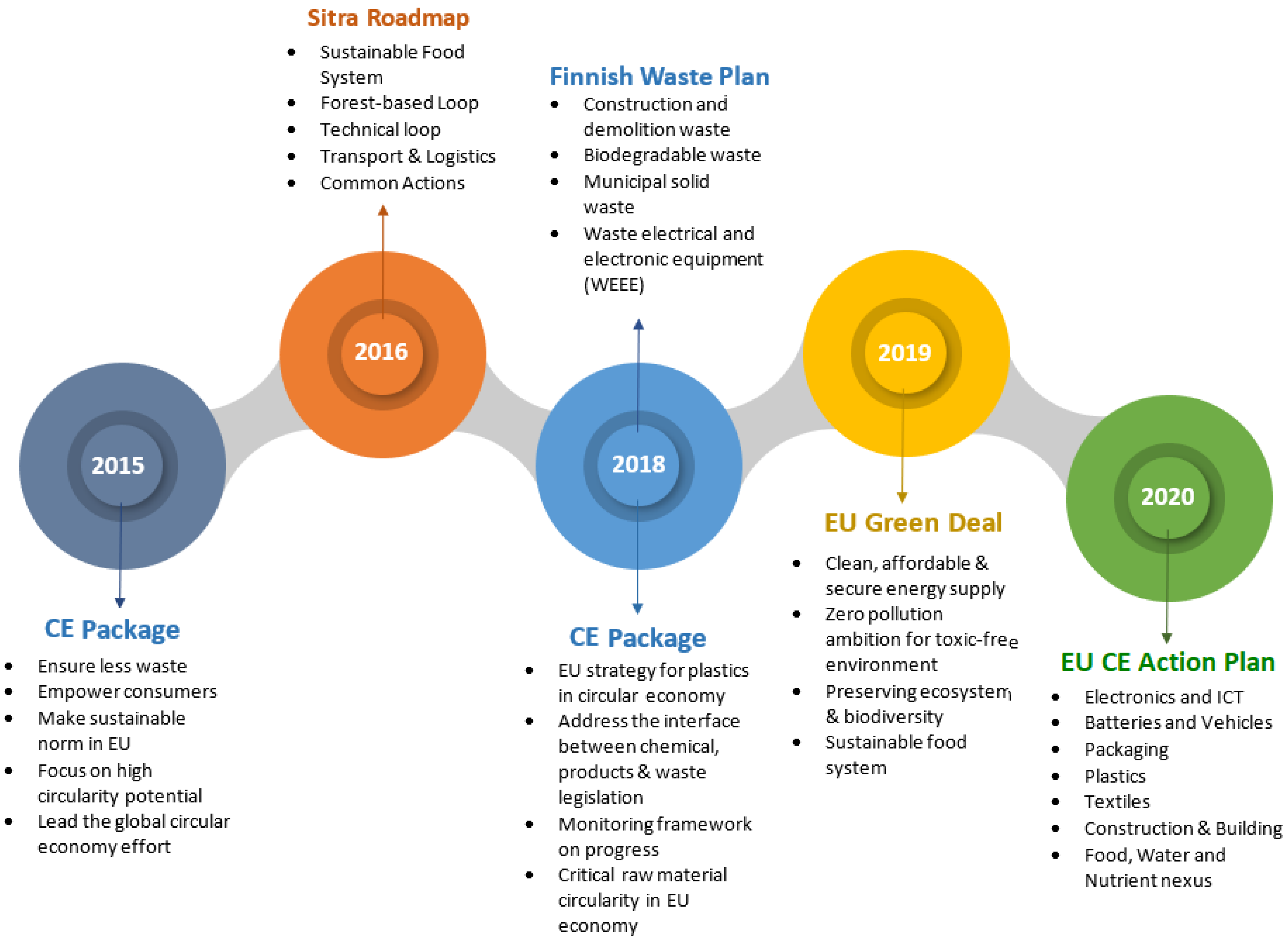
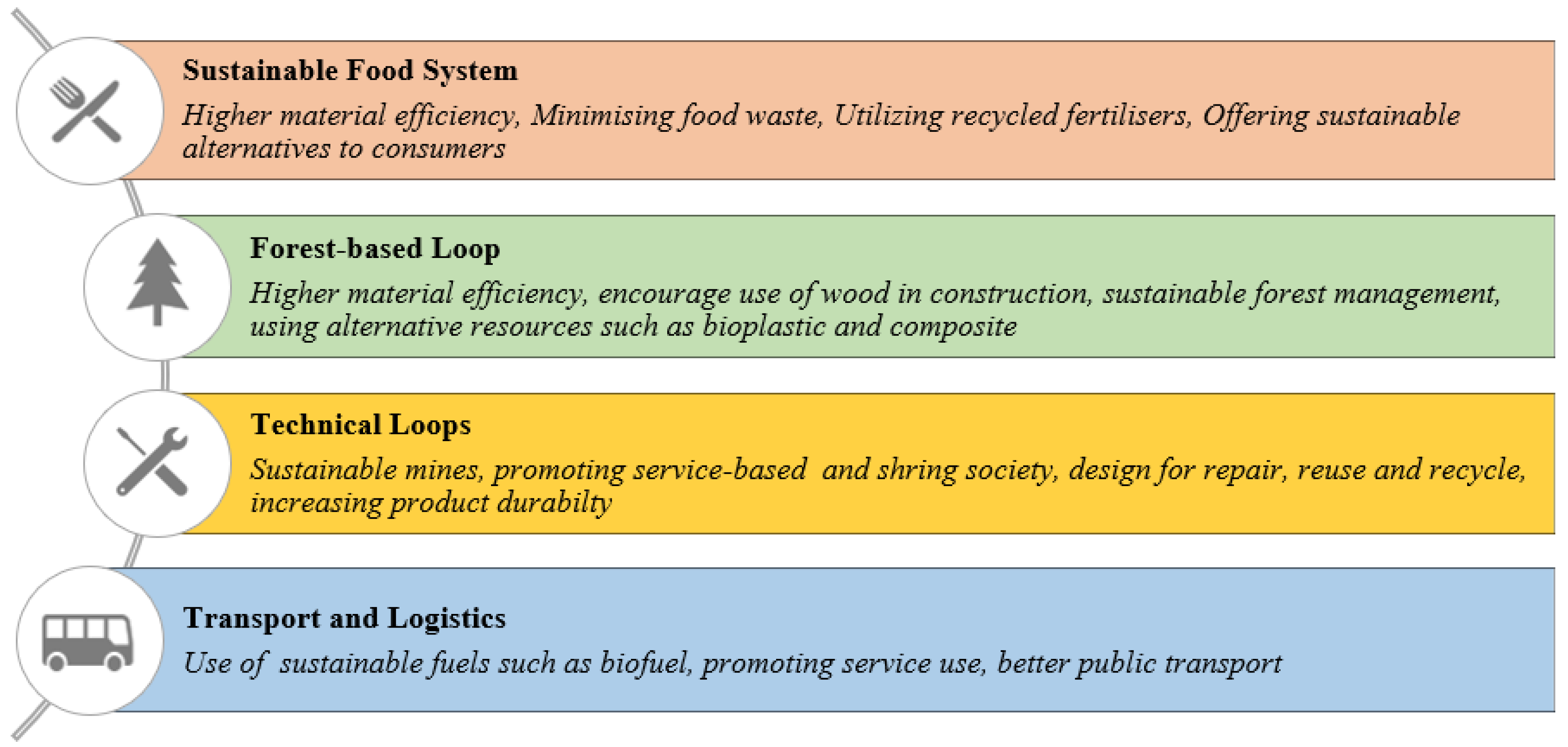

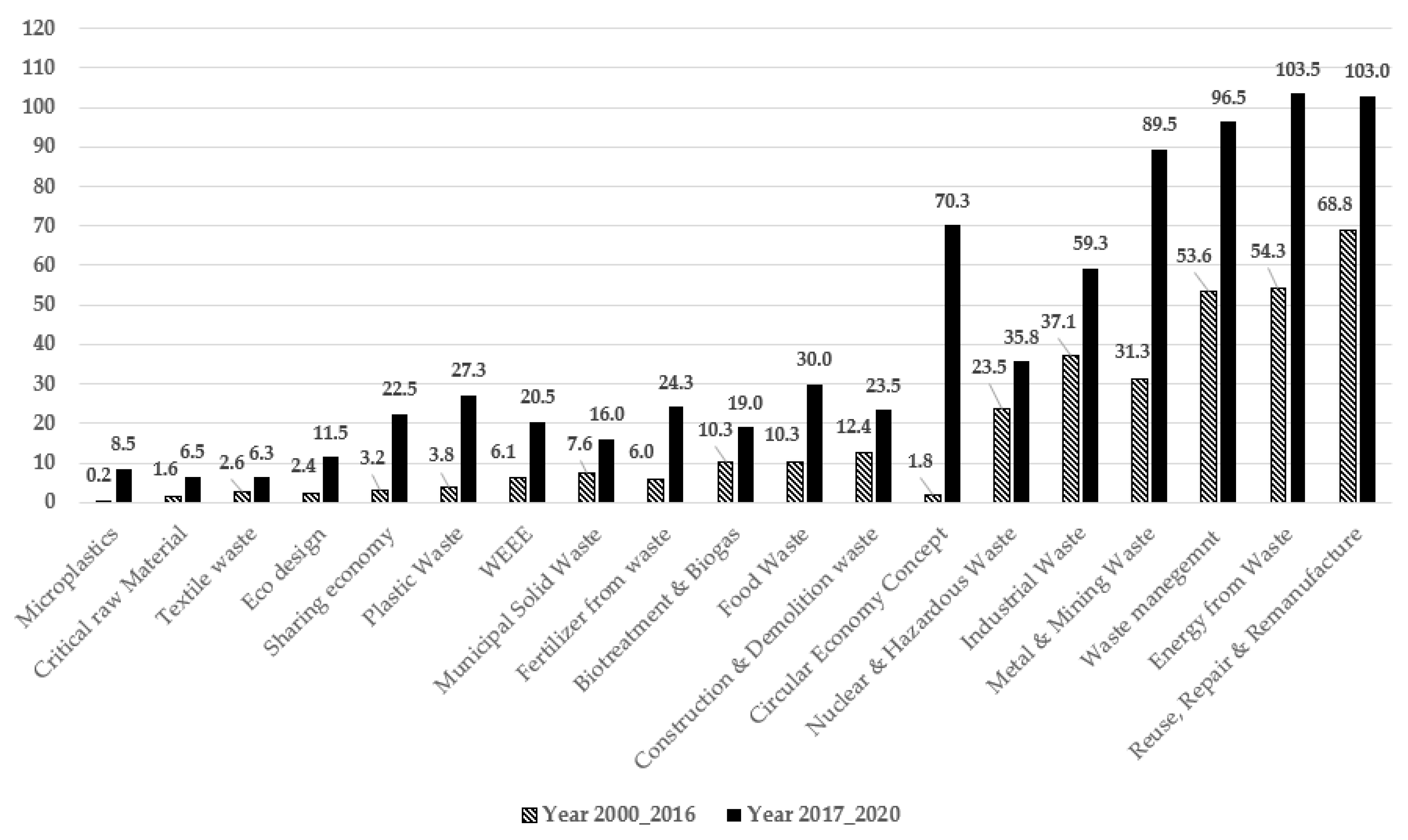
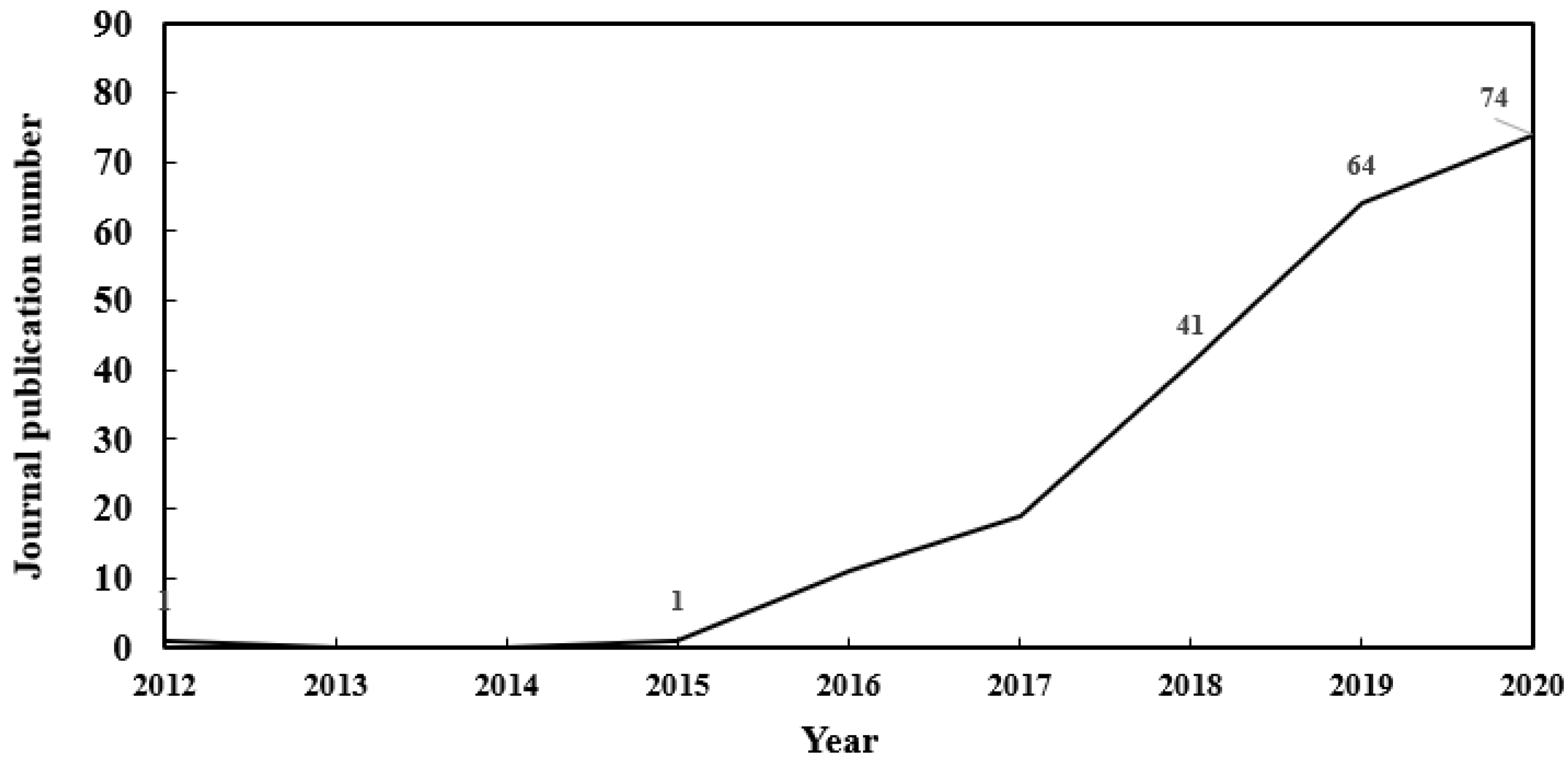

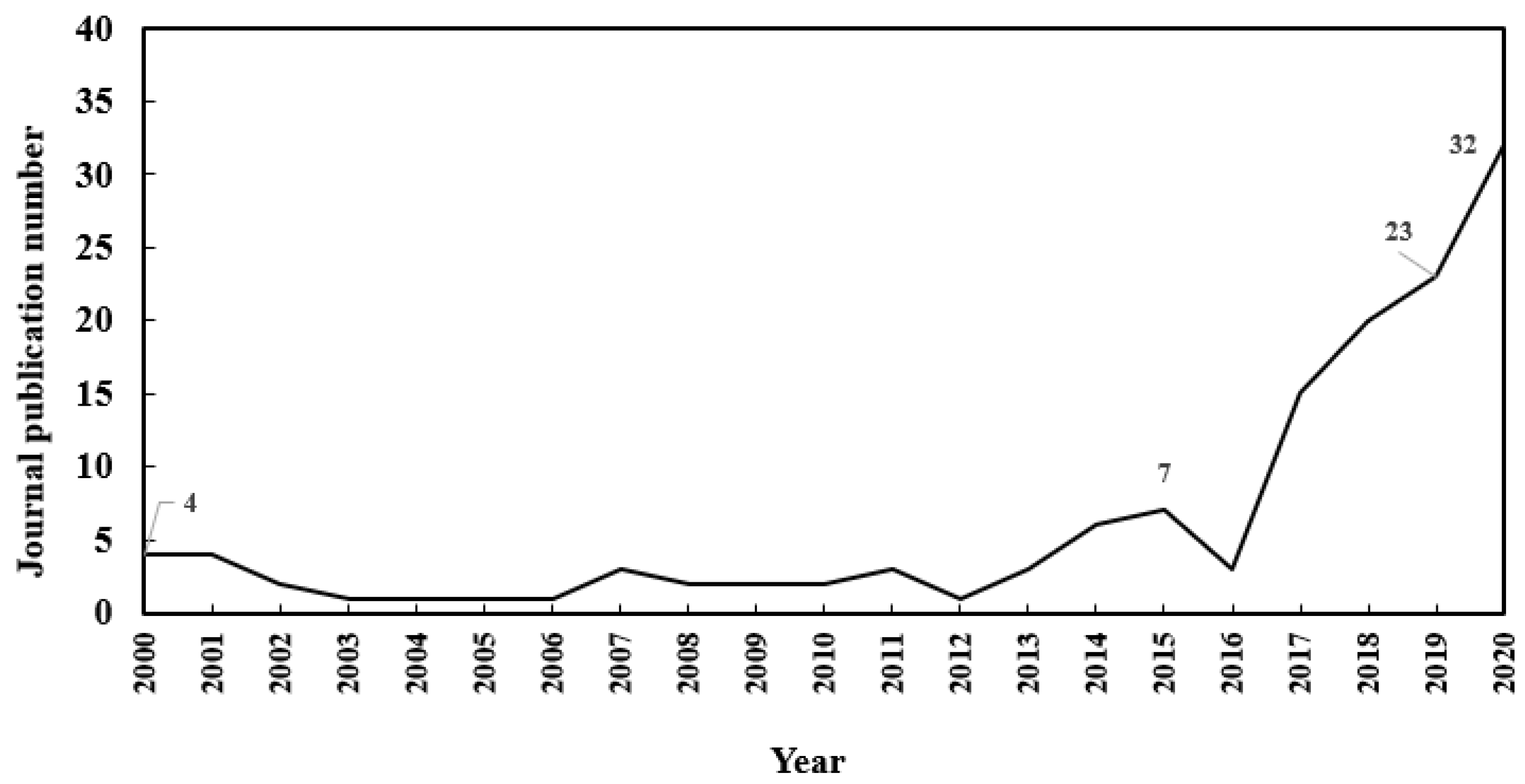
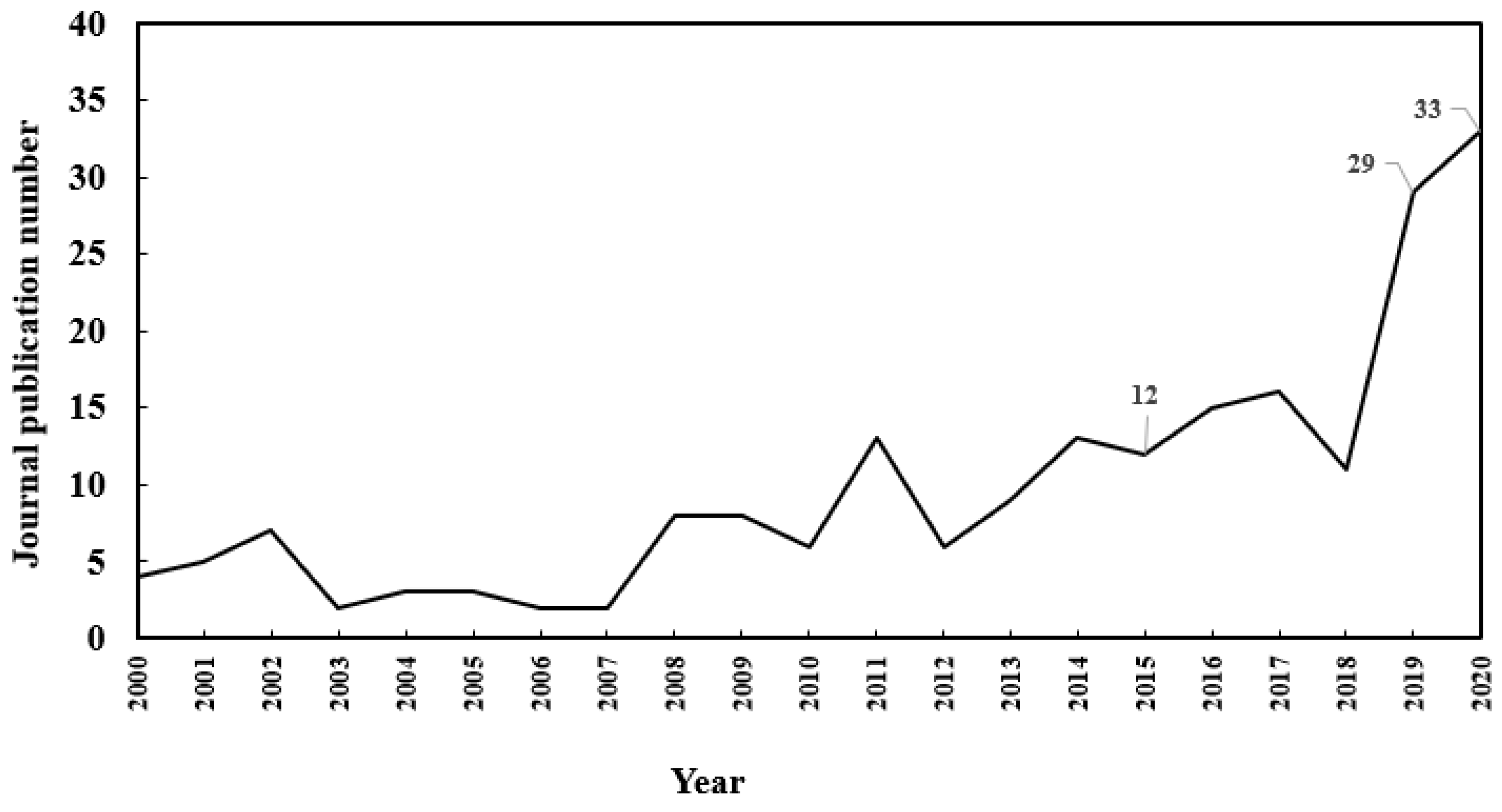
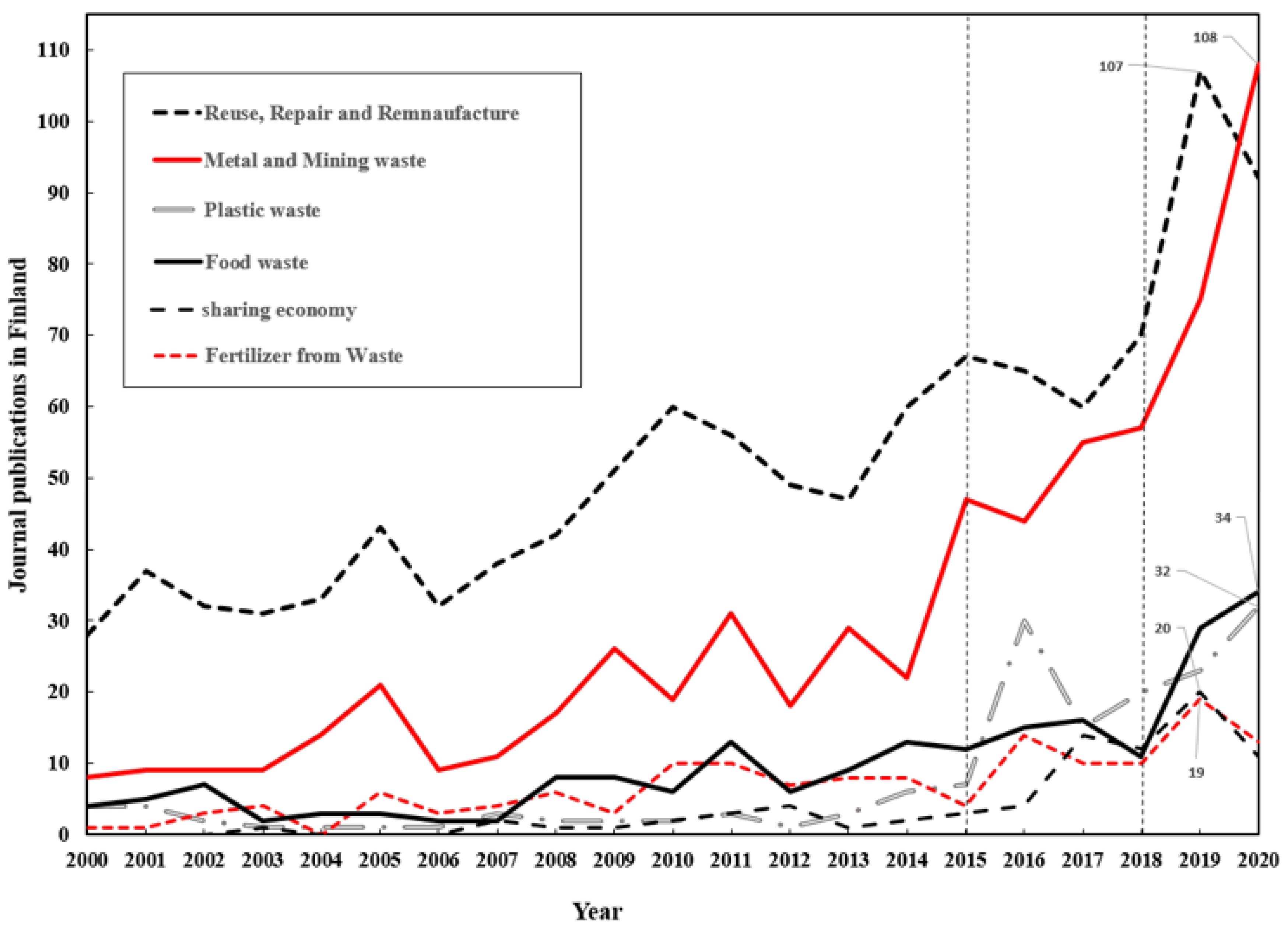
| Category | Selection References | Search Keywords |
|---|---|---|
| Circular Economy Concept | Circular Economy package 2018, Sitra Roadmap 2016, Finnish waste plan 2018, | Circular AND Economy |
| Energy from Waste | European Green Deal 2019 | Waste AND Energy Waste AND Incineration OR Combustion |
| Bio-treatment and Biogas | Finnish Waste Plan 2018 | Biotreatment AND Waste Biogas |
| Municipal Solid Waste (MSW) | Finnish Waste Plan 2018 | Municipal AND Solid AND Waste MSW |
| Plastic Waste | Circular Economy package 2018, European Action Plan 2020 | Plastic AND Waste |
| Industrial Waste | Sitra Roadmap 2016, European Action Plan 2020 | Industrial AND Waste OR Byproduct OR Sidestream |
| Waste Electrical and Electronic Equipment (WEEE) | European Action Plan 2020, Finnish Waste Plan 2018 | Electronic AND Waste Electrical AND Waste |
| Nuclear and Hazardous Waste | European Green Deal 2019 | Nuclear OR Hazardous AND Waste |
| Food Waste | Sitra Roadmap 2016, European Green Deal 2019, European Action Plan 2020 | Food AND Waste |
| Fertilizer from Waste | European Action Plan 2020 | Biofertilizer OR Fertilizer AND Waste |
| Biomass and Wood Waste | Sitra Roadmap 2016 | Biomass OR Wood AND Waste |
| Construction and Demolition Waste | European Action Plan 2020, Finnish Waste Plan 2018 | Construction OR Demolition AND Waste |
| Metal and Mining Waste | Sitra Roadmap 2016 | Mine AND Tailing Mine OR Metal AND Waste |
| Microplastics | European Green Deal 2019 | Microplastic |
| Waste Management | Circular Economy package 2018 | Waste AND Management |
| Reuse and Remanufacture | European Green Deal 2019, European Action Plan 2020 | Reuse Remanufacture Refurbish Repair |
| Critical Raw Material | Circular Economy package 2018, Finnish Waste Plan 2018 | Critical AND Raw AND Material |
| Textile Waste | European Action Plan 2020 | Textile AND Waste |
| Sharing Economy | European Green Deal 2019, European Action Plan 2020 | Service-based OR Sharing AND Economy |
| Eco-design | European Green Deal 2019 | Ecodesign |
| Category | Year 2000–2016 | Year 2017–2020 | Increase %/Year | |
|---|---|---|---|---|
| 1 | Microplastics | 3 | 34 | 4433 |
| 2 | Critical Raw Material | 26 | 26 | 300 |
| 3 | Circular Economy Concept | 29 | 281 | 3776 |
| 4 | Eco-design | 38 | 46 | 384 |
| 5 | Textile Waste | 41 | 25 | 144 |
| 6 | Sharing Economy | 51 | 90 | 606 |
| 7 | Plastic Waste | 61 | 109 | 615 |
| 8 | Fertilizer from Waste | 96 | 97 | 304 |
| 9 | WEEE | 97 | 82 | 238 |
| 10 | Municipal Solid Waste | 121 | 64 | 112 |
| 11 | Food Waste | 165 | 120 | 84 |
| 12 | Biotreatment and Biogas | 165 | 76 | 191 |
| 13 | Construction and Demolition Waste | 199 | 94 | 89 |
| 14 | Nuclear and Hazardous Waste | 376 | 143 | 52 |
| 15 | Metal and Mining Waste | 500 | 358 | 186 |
| 16 | Industrial Waste | 594 | 237 | 60 |
| 17 | Waste Management | 858 | 386 | 80 |
| 18 | Energy from Waste | 869 | 414 | 91 |
| 19 | Reuse, Repair and Remanufacture | 1101 | 412 | 50 |
| 20 | Biomass and Wood Waste | 4023 | 1099 | 9 |
Publisher’s Note: MDPI stays neutral with regard to jurisdictional claims in published maps and institutional affiliations. |
© 2021 by the authors. Licensee MDPI, Basel, Switzerland. This article is an open access article distributed under the terms and conditions of the Creative Commons Attribution (CC BY) license (https://creativecommons.org/licenses/by/4.0/).
Share and Cite
Hosseinian, A.; Ylä-Mella, J.; Pongrácz, E. Current Status of Circular Economy Research in Finland. Resources 2021, 10, 40. https://0-doi-org.brum.beds.ac.uk/10.3390/resources10050040
Hosseinian A, Ylä-Mella J, Pongrácz E. Current Status of Circular Economy Research in Finland. Resources. 2021; 10(5):40. https://0-doi-org.brum.beds.ac.uk/10.3390/resources10050040
Chicago/Turabian StyleHosseinian, Aida, Jenni Ylä-Mella, and Eva Pongrácz. 2021. "Current Status of Circular Economy Research in Finland" Resources 10, no. 5: 40. https://0-doi-org.brum.beds.ac.uk/10.3390/resources10050040








